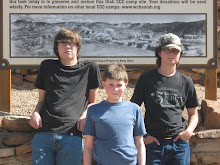Social behavior and intelligence
Scientists say dromaeosaurs like Utahraptor probably hunted in packs. I believe this is true. I also think that they lived together in these packs full time. The pack they lived in was almost like their family, even if there were few or no actual blood relations. They would have competed for food, territory, and the right to mate in these packs. They could've also acted as a team to bring down an animal several times their size. In order to do this, they may have had some form of communication, like we do today, but probably not to our extent. Utahraptor packs would have usually consisted of an alpha female, and at least three others; probably most of the rest were males. Few dromaeosaur egg specimens are in human possession today, although as time progresses, we may find more.
*****************************************************
Dromaeosaurs were one of the most intelligent groups of dinosaurs that ever existed, second only to the troodonts. They were master strategists. Paleontologists figure out relative dinosaur intelligence based on their Encephalization Quotient, or EQ. Basically put, an EQ is the brain to body mass ratio. For example, for humans, the figure comes out at about 7:14, but this does not always determine high intelligence. The EQ of a bird is about 7:20, which would make them appear smarter than humans. The EQ of a troodont is about 6 even, and dromaeosaurs aren’t far behind; with an average EQ of about 5.87 or higher. The EQ of Utahraptor is about the same as a troodont, which makes Utahraptor the most intelligent dromaeosaur, and possibly dinosaur, of all time. Utahraptor was probably just as smart as a modern-day fox.
Pack hunting: An example of what it might look like
Pay close attention to the following description of how a pack of Utahraptor might have brought down its prey. Bear in mind that Utahraptor and Triceratops lived millions of years apart, and a meeting like this would be impossible.
*****************************************************
A herd of Triceratops is grazing in the prairie. The ferns are tall and thick, but the Triceratops don’t seem to mind. In fact, they are feeding on these high ferns. They have a baby with them. The little guy is in the middle of the herd. None of them suspect what will happen next…
A lone Utahraptor leaps out of its hiding place and races toward the herd of Triceratops. They turn to face the Utahraptor, and get into a defensive circle. The Utahraptor can’t get past the Triceratops! Suddenly, from behind, 5 more Utahraptor race to the center of the herd, since the back of the defense shield is open. They get to the baby, but one of the adults sees them! It quickly warns the others, and they face the other way. Then the lone Utahraptor snatches the baby and runs. The rest of the pack follows…all except one. That one is fighting off the mother of the baby they killed. The mother tries to gouge the Utahraptor with its horns. The Utahraptor jumps out of the way, and the Triceratops’ horns harmlessly hit the dirt. The last Utahraptor finally gets away unharmed. The Triceratops make barking sounds, almost like dogs, at the Utahraptor as they retreat into the night…



